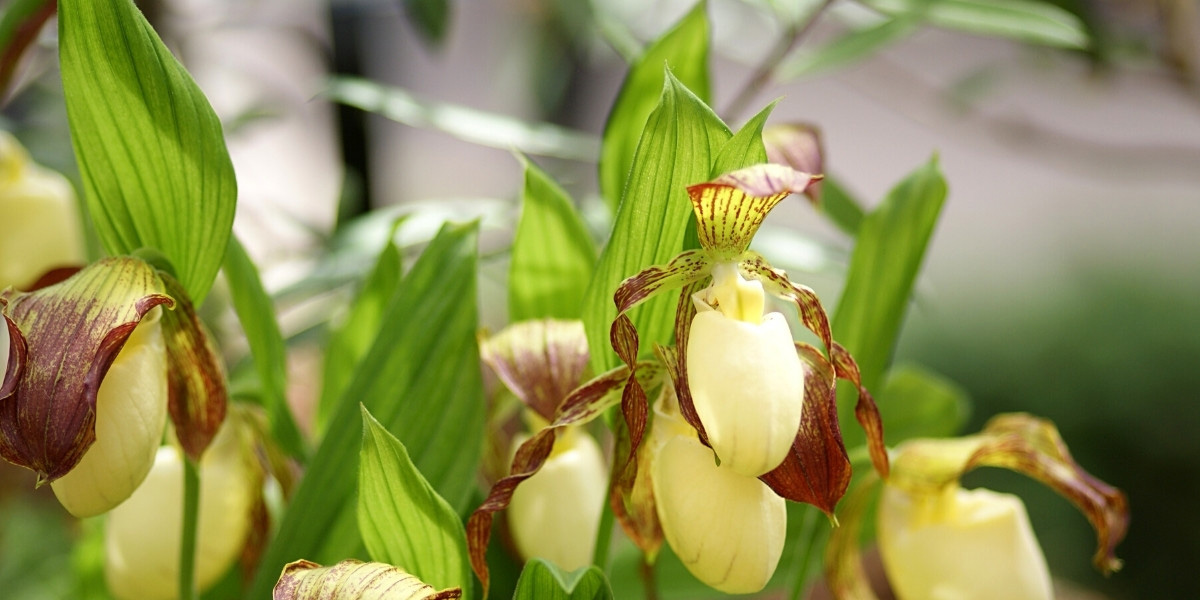
Garden orchids: planting, cultivating and maintaining
Contents
Garden orchids in a nutshell
- Garden orchids offer beautiful flowers that are both sophisticated and very natural
- They come in a wide variety of shapes and colours
- They blend perfectly into naturalistic gardens
- Some orchids will thrive on pond banks, in rockeries, or in woodland settings
The word from our expert
Garden orchids are perennial plants cherished for the uniqueness of their flowers, both sophisticated and yet very natural in style. They possess all the charm of wildflowers and create a lovely naturalistic atmosphere in gardens! Their flowers come in a wide variety of shapes and colours. From the impressive Lady’s Slippers (Cypripedium) to the very poetic white flowers of the Habenaria, and the stunning colourful blooms of the Bletillas, Calanthes, and Pleiones, discover the full diversity of garden orchids!
Garden orchids easily find their place in naturalistic gardens. Most thrive in partial shade or non-scorching sun, in cool, rather poor, neutral to acidic soil. However, due to their diversity, they adapt to various conditions depending on the species: some, for example, will thrive on the banks of a pond, others in woodland settings, or in pots on the terrace. Discover all our tips for successfully growing garden orchids in this guide!
botany
Botanical data
- Latin name Bletilla sp, Calanthe sp, Cypripedium sp…
- Family Orchidaceae
- Common name garden orchids
- Flowering between May and August depending on the species
- Height generally between 20 and 50 cm
- Exposure partial shade or non-scorching sun
- Soil type fresh, poor and well-draining, rather acidic
- Hardiness variable, between –5 and –20 °C
Orchids are well known for their refined and colourful flowers that decorate our interiors, but there are also many hardy species that can be grown outdoors in our climates. These originate from temperate regions around the globe, particularly Asia and Europe. In the wild in France, there are around 160 species of orchids, many of which are protected. Notable genera include Dactylorhiza, Cypripedium, Epipactis, Orchis, Ophrys… The Bletillas and Pleiones come from Asia, where they typically grow at high altitudes in mountainous regions, which is why they are relatively hardy.
Orchids are grouped in their own botanical family, the Orchidaceae. With 18,500 to 20,000 species, it is one of the largest families of flowering plants. They are herbaceous perennials appreciated for their original flowers, sometimes very sophisticated, and their natural style. Hardy garden orchids are a minority. They are terrestrial, growing in the ground, whereas many tropical orchids are epiphytic, growing on tree trunks.
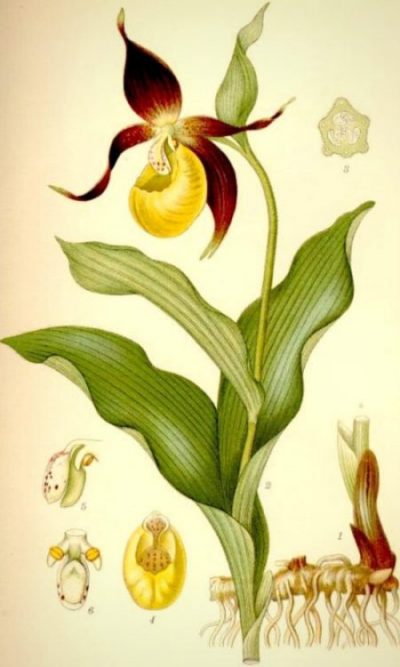
Cypripedium calceolus: Botanical illustration
Beware of confusion: some garden plants resemble orchids in the shape of their flowers but are not orchids. This is the case, for example, with Roscoea and Tricyrtis, which are nicknamed Ginger-orchid and Lily-orchid.
This generic name of garden orchids hides a great diversity, both in growing conditions and ease of cultivation, as well as in style, flower colour, or plant size. Garden orchids are varied and very different depending on the species! For example, the Bletilla is one of the easiest garden orchids to grow, while Cypripediums and Orchis are much more demanding and delicate to succeed with.
Garden orchids most often measure between 20 and 50 cm in height. The tallest are the Cypripediums (40 to 70 cm, even 80 cm for the Cypripedium kentuckiense) and the Epipactis gigantea (70-80 cm)… while the shortest are the Pleiones, which do not exceed 15-20 cm and paradoxically have very large flowers (about 8 cm) relative to their total height!
The clumps of Bletilla spread quite quickly. When conditions suit it, it can even naturalise!
Garden orchids bloom in spring or summer, usually between May and August. The Pleiones are the first to flower, in April-May. Next come the Calanthes, the Bletillas, then the Cypripediums. The latest is the Spiranthes ‘Chadd’s Ford’, which usually flowers in October-November.
The flowers of orchids are often clustered in spikes at the top of upright stems, very rigid. However, the shape of the inflorescences differs depending on the species: Dactylorhiza bears dense spikes made up of many flowers, Calanthe bears much looser and airier clusters of flowers, while Cypripedium and Pleione bear solitary flowers.

The flowers of Bletilla striata, Epipactis gigantea, and Pleione formosana
Orchids are appreciated for their original, very sophisticated flowering. Their flowers are complex and very characteristic. They consist of three external sepals, usually coloured and resembling petals, which surround three true petals. The central petal is the lip: it is a well-developed petal, particularly decorative, often of a different colour compared to the other two petals. Orchid flowers are resupinate: they twist 180°. The lip should be at the top of the flower, but due to this twist, it ends up at the bottom. The lip is sometimes equipped with a spur containing the nectar that feeds pollinating insects. Orchid flowers are hermaphroditic: they bear both stamens (male reproductive organs, carrying pollen) and the pistil (female reproductive organ, receiving pollen). The stamens are fused to the pistil to form the gynostemium. The pollen grains also have the particularity of being grouped into masses called pollinia. Some species offer fragrant flowers: this is notably the case with the Spiranthes ‘Chadd’s Ford’.
The most delicate flowers are undoubtedly those of the Habenaria radiata. Small in size (about 3 cm in diameter) and entirely white, they resemble tiny doves ready to take flight. In contrast, the most impressive flowers are those of the Cypripedium, particularly the species Cypripedium kentuckiense, which can reach up to 12-13 cm in diameter and consist of a large white throat (lip), surrounded by long, slender purple sepals.
The flowers of the Pleiones and Bletillas resemble those of indoor orchids, grown in pots in homes. They look like the flowers of the Cattleya.
Many orchid species require a specific insect for pollination. The Ophrys create a sexual lure to attract insects. The flower mimics the abdomen of the female of the pollinating insect and simultaneously releases pheromones, so the males are attracted and become covered in pollen while attempting to mate with the flower!
The flowers of the Cypripediums constitute a real insect trap: the bee that pollinates them is attracted by the shape, colour, and pheromones emitted by the flower. It enters the slipper-shaped lip, then cannot find the exit and is eventually guided through a narrow passage that will take it past the stigma, then the pollen-covered anthers, before it can escape. It will thus carry the pollen to another Cypripedium flower, being trapped again and depositing the pollen on the stigma.

The flowers of Calanthe tricarinata, Cypripedium kentuckiense, and Habenaria radiata
Orchids generally have fairly ordinary and discreet leaves. They are green, oval in shape, with parallel veins (a characteristic of monocotyledons). They are usually alternate, inserted one after another on the stem. The leaves of the Habenaria radiata are long and very thin: they resemble grass leaves and do not exceed 1 cm in width. The Calanthe sieboldii, on the other hand, has large leaves with well-marked veins, resembling the leaves of veratrums and gentians. The Cypripedium japonicum stands out for its very surprising fan-shaped leaves.
There are also variegated orchids: for example, the Bletilla ‘Alba Variegata’ and the Bletilla ‘Gotemba Stripes’. The Epipactis gigantea ‘Night Serpentine’ stands out for its purple foliage. The Calanthe argenteostriata has very beautiful green leaves streaked with silver-grey.
Most garden orchids are deciduous. This is the case, for example, with Cypripediums, Pleiones, Bletillas, Dactylorhiza, and Epipactis. After flowering, the foliage withers, and the plant then goes dormant. It is important that the soil is well-draining and does not become waterlogged in winter, otherwise the pseudobulbs may rot.
The hardy Calanthes and the Spiranthes ‘Chadd’s Ford’ are semi-evergreen. They may lose their leaves in the case of low winter temperatures but retain them in climates where winters are mild.
After flowering, orchids produce capsules that open at maturity to release a multitude of tiny seeds, resembling dust. They are dispersed by the wind. The seeds do not contain the nutrient reserves needed for germination: they must associate with a fungus (symbiosis), which will provide them with the necessary elements. They therefore need the fungus to feed, which makes them difficult to propagate by sowing.
Unlike most orchids, the Bletilla does not live in symbiosis with a fungus, making it much easier to establish in the garden.
Hardiness varies greatly depending on the species. Cypripediums are generally very hardy (some can withstand up to –30 °C), while Pleiones and the Habenaria radiata orchid are quite tender (down to –4 °C).
Read also
Plant your BletillasThe main varieties

Bletilla striata Rose - Chinese Ground Orchid
- Flowering time July, August
- Height at maturity 50 cm
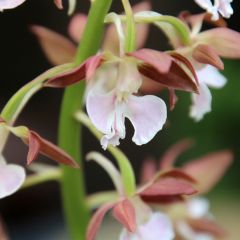
Calanthe discolor - Garden orchid
- Flowering time June, July
- Height at maturity 40 cm
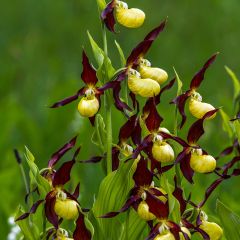
Cypripedium calceolus
- Flowering time June to August
- Height at maturity 40 cm

Pleione formosana
- Flowering time May, June
- Height at maturity 15 cm
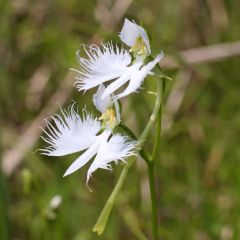
Habenaria radiata
- Flowering time August, September
- Height at maturity 25 cm

Spiranthes Cernua var odorata - Chadds Ford
- Flowering time November, December
- Height at maturity 50 cm
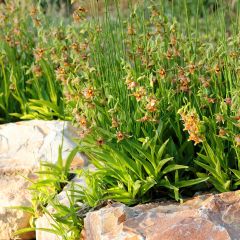
Epipactis gigantea
- Flowering time June to August
- Height at maturity 70 cm
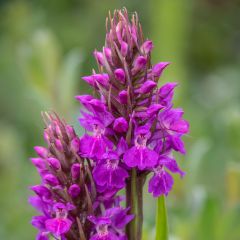
Dactylorhiza praetermissa - Marsh Orchid
- Flowering time June to August
- Height at maturity 50 cm

Calanthe tricarinata - Garden orchid
- Flowering time June
- Height at maturity 60 cm
Discover other Garden Orchids
View all →Available in 0 sizes
Available in 0 sizes
Available in 0 sizes
Available in 0 sizes
Available in 0 sizes
Available in 0 sizes
Available in 0 sizes
Available in 1 sizes
Available in 1 sizes
Planting
Where to Plant?
Most garden orchids thrive in partial shade or non-scorching sunlight. Ideally, they should enjoy morning sun but be under dappled shade in the afternoon during the hottest hours. This also depends on your geographical location: in northern France, plant them in full sun, while in the south, partial shade is preferable. Choose a spot sheltered from cold winds as well. Garden orchids generally prefer soils that remain cool in summer, lean and well-draining, neutral to acidic. However, growing conditions vary by species. For example, the Cypripedium calceolus prefers calcareous soils.
Some orchids are ideal for embellishing the edges of a pond, as they like cool to moist soils. Consider species like Epipactis, Spiranthes, Bletillas, and Dactylorhiza praetermissa.
Calanthes thrive in shade or partial shade: they are perfect for woodland settings, in cool, rich, and humus-bearing soil.
The most cold-sensitive orchids benefit from being planted in pots, to protect them from winter cold. This applies, for example, to Pleiones and Habenaria radiata. Similarly, if your soil is calcareous, we recommend growing them in pots or choosing a species adapted to such conditions, like Cypripedium calceolus.
When to Plant?
We recommend planting garden orchids in spring, around April. Avoid planting during frost or extreme heat!
How to Plant?
In the ground:
- Dig a planting hole. If your soil is heavy, don’t hesitate to add drainage materials, such as gravel or coarse sand, mixed into the planting soil. Similarly, if you’re planting Bletillas or Calanthes, you can add well-decomposed compost, as they appreciate rich and fertile soils (while other garden orchids prefer lean soils).
- You can fill the planting hole with 1/3 coarse sand (for drainage), 1/3 garden soil, and 1/3 compost.
- If your orchid was in a pot, place the potting mix into the planting hole, as it contains the symbiotic fungus the orchid needs to thrive.
- Plant the pseudobulb in the planting hole. It should be buried 5 to 7 cm deep. Then cover it with substrate. If your orchid was in a pot, plant it in the centre of the hole, ensuring the collar isn’t buried, and replace the substrate around it.
- Water generously.
In pots:
Planting in pots is a great solution for the most cold-sensitive orchids, like Pleiones and Habenaria radiata, as it allows you to easily move them indoors for winter.
- Choose a pot with drainage holes.
- Place a layer of gravel or clay pebbles at the bottom.
- Add a special orchid substrate or a mix of compost, coarse sand, and heather soil (for acidity).
- Plant the orchid in the centre, then fill in with substrate around it.
- Water generously.

The flowers of the Lady’s Slipper, Cypripedium calceolus
Maintenance
Most garden orchids thrive in poor soil and do not particularly need fertiliser. This is especially true for Cypripediums. However, you can provide fertiliser to Bletillas and Calanthes, especially if they are potted. Opt for a balanced, slow-release fertiliser, to be applied in early spring and summer.
We recommend cutting the flower spike when you notice the flowers have faded, both for aesthetic reasons and to help the plant conserve its energy.
Orchids prefer soil that remains relatively cool, so we advise regular watering in summer. When watering, use rainwater if possible, as most orchids dislike lime. Additionally, consider adding a layer of mulch around the clump: this will help keep the soil cool for longer and reduce the frequency of watering and weeding. Reduce watering in autumn and winter. Orchids are sensitive to excess moisture, which can cause their pseudobulbs and root system to rot.
If you grow them in pots, bring the less hardy orchids indoors in autumn, particularly Pleiones and Habenaria radiata. Place them in a frost-free but cool shelter. Garden orchids are not houseplants: they require a period of relative cold, ideally at temperatures between 1 and 4 °C. You can move them back outside in spring, around April.
If you do not bring them indoors, we recommend laying a thick layer of mulch (such as dead leaves) over the clump in autumn to protect the pseudobulb from the cold.
Slugs and snails enjoy nibbling on young orchid shoots. You can protect them by setting up a slug trap or using slug repellent. Bletillas are sometimes attacked by aphids.
Multiplication
Sowing orchids is complicated because the seeds do not contain any nutrients and must associate with a fungus to germinate. It is better to propagate them by dividing clumps.
Dividing Clumps
Bletillas and Pleiones propagate quite well by division. You can divide the clumps every 3 to 4 years.
- Choose a well-established orchid that has been in place for several years and has started to spread.
- Dig it up by digging wide enough to avoid damaging the roots. If it is in a pot, remove the root ball carefully.
- Separate the rootstock into several sections using a clean, sharp blade. Each section should retain roots and one or more pseudobulbs.
- Remove dead leaves and dried roots if you see any.
- Replant in a pot or in the ground after preparing the soil.
- Water generously.
Association
Garden orchids are ideal for creating a naturalistic garden! You can pair them with other perennials featuring light and airy flowering, such as penstemons, gauras, Buenos Aires vervains, willowherbs, yarrows, and hardy geraniums. Don’t hesitate to add a few clumps of ornamental grasses, such as Pennisetums or Stipas. This will give your garden a wild meadow feel. You can highlight these free and airy blooms by creating neat borders and pathways where the short grass meadow is carefully mown, creating a lovely contrast!
Thriving in moist soil, the Epipactis, the Spiranthes ‘Chadd’s Ford’, and the Dactylorhiza praetermissa will find their place on the banks of a pond. Pair them with Japanese primroses, willowherbs, meadowsweets, and astilbes. Also consider ferns, such as Matteuccia struthiopteris, Thelipteris palustris, and royal ferns.
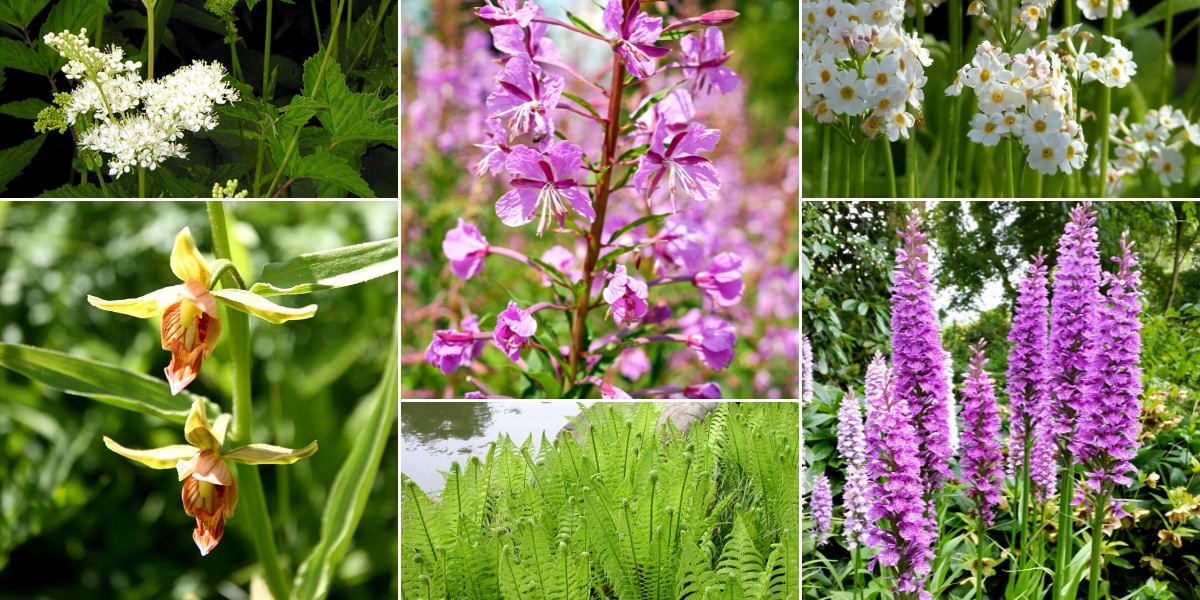
Some garden orchids are perfect for adorning pond banks alongside other moisture-loving perennials. Here, Filipendula ulmaria (photo Algirdas), Epilobium angustifolium, Primula japonica ‘Alba’, Epipactis gigantea, Matteuccia struthiopteris (photo Ryan Somma), and Dactylorhiza praetermissa
In a woodland garden, plant shade-loving orchids like calanthes. We particularly recommend the stunning Calanthe tricarinata, which boasts a beautiful flowering in warm tones of yellow and orange. It will be ideal for bringing brightness to a shady corner of the garden! You can pair it with ferns, brunneras, hostas, Solomon’s seals, trilliums, sweet woodruffs, and barrenworts. Also consider wild garlic, which offers charming white flowers in spring!
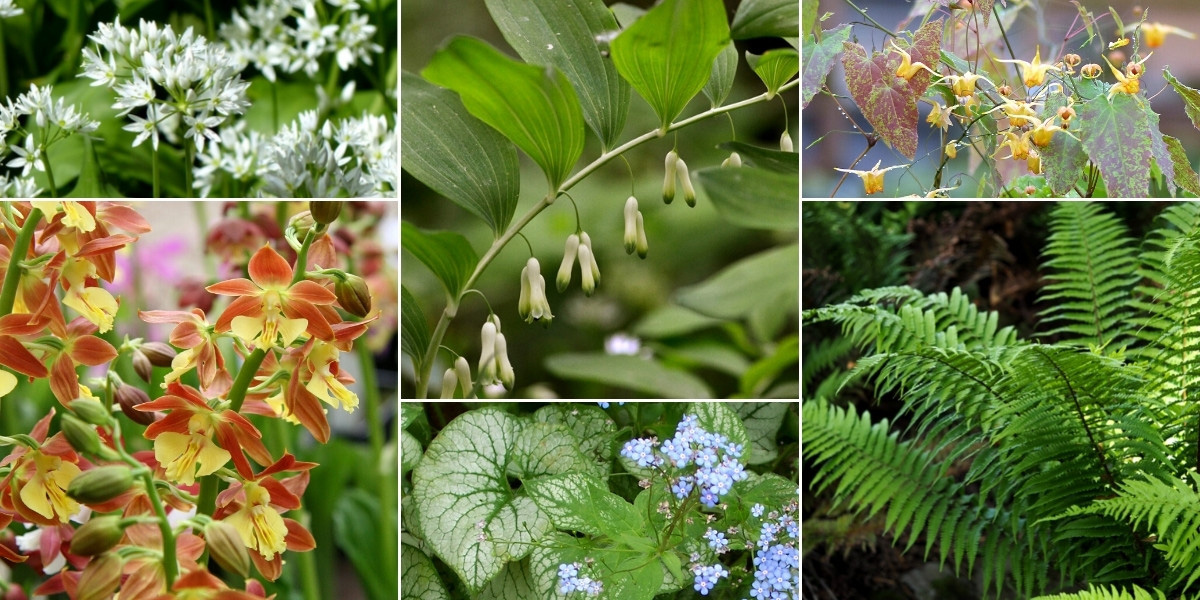
Shade-loving garden orchids, particularly calanthes, will thrive in a woodland garden. Here, Allium ursinum, Polygonatum multiflorum (photo Radio Tonreg), Epimedium ‘Amber Queen’, Calanthe tricarinata, Brunnera ‘Jack Frost’, and Dryopteris wallichiana
Useful resources
- Discover our full range of garden orchids!
- Feel free to explore our detailed guides on growing Calanthes, Cypripediums, Bletillas, Pleiones, and Dactylorhiza.
- The website of the French Orchid Federation
- Our advice sheet: Hardy orchids to grow in the garden
- Subscribe!
- Contents































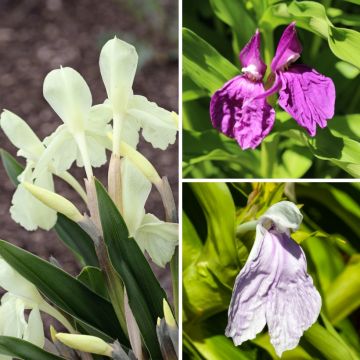
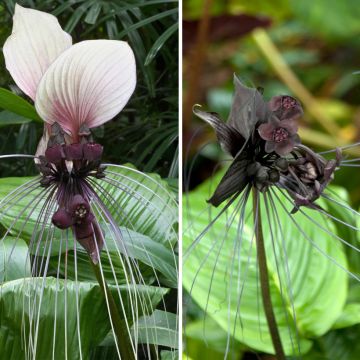
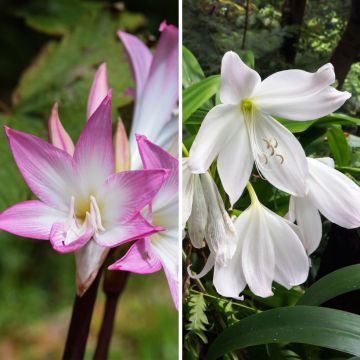



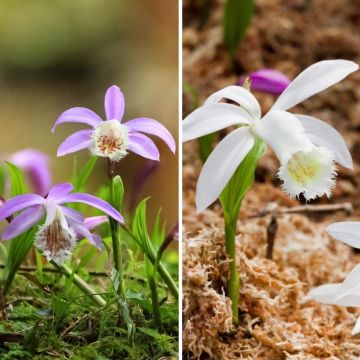

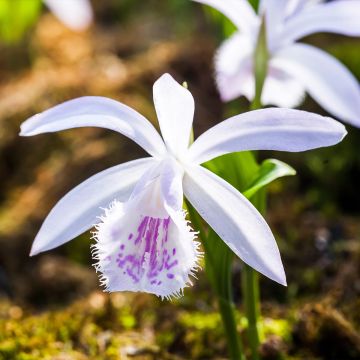

Comments